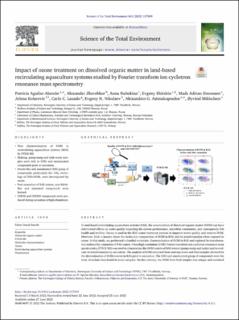| dc.contributor.author | Aguilar Alarcon, Patricia Amparo | |
| dc.contributor.author | Zherebker, Alexander | |
| dc.contributor.author | Rubekina, Anna | |
| dc.contributor.author | Shirshin, Evgeny | |
| dc.contributor.author | Simonsen, Mads | |
| dc.contributor.author | Kolarevic, Jelena | |
| dc.contributor.author | Lazado, Carlo C. | |
| dc.contributor.author | Nikolaev, Evgeny N. | |
| dc.contributor.author | Asimakopoulos, Alexandros | |
| dc.contributor.author | Mikkelsen, Øyvind | |
| dc.date.accessioned | 2023-02-09T07:57:18Z | |
| dc.date.available | 2023-02-09T07:57:18Z | |
| dc.date.created | 2022-09-16T13:40:40Z | |
| dc.date.issued | 2022 | |
| dc.identifier.citation | Science of the Total Environment. 2022, 843 . | en_US |
| dc.identifier.issn | 0048-9697 | |
| dc.identifier.uri | https://hdl.handle.net/11250/3049497 | |
| dc.description.abstract | In land-based recirculating aquaculture systems (RAS), the accumulation of dissolved organic matter (DOM) can have detrimental effects on water quality impacting the system performance, microbial community, and consequently fish health and welfare. Ozone is used in the RAS water treatment process to improve water quality and remove DOM. However, little is known about the molecular composition of DOM in RAS and its transformation when exposed to ozone. In this study, we performed a detailed molecular characterization of DOM in RAS and explored its transformation induced by ozonation of RAS waters. Ultra-high resolution (UHR) Fourier transform ion cyclotron resonance mass spectrometry (FTICR MS) was used to characterize the DOM matrix of RAS waters (pump-sump and tanks) and to evaluate its transformation by ozonation. The analysis of DOM extracted from makeup water and feed samples allowed for the determination of DOM sources in RAS prior to ozonation. The CHO and unsaturated group of compounds were the most abundant class found in water samples. On the contrary, the DOM from feed samples was unique and consisted mainly of CHO, CHON and unsaturated group of compounds. After the ozonation of RAS waters, humic-like and unsaturated compounds [positive oxygen subtracted double bond equivalent per carbon (DBE–O)/C)] were decomposed, particularly the CHO-DOM that contained fewer -CH2- features. Fulvic-like compounds and several hundred saturated compounds [negative (DBE–O)/C)] were formed post ozonation, particularly the CHON and CHONS group of compounds that were associated with fish diets, makeup waters and transformation products from the ozonation of the RAS waters. This study showed that the high accuracy of the ultra-high resolution FTICR MS can be applied to characterize and monitor the changes of DOM at a molecular level in RAS waters. To our knowledge, this is the first study where FTICR MS was incorporated for the characterization of DOM and its sources in RAS. | en_US |
| dc.language.iso | eng | en_US |
| dc.publisher | Elsevier Science | en_US |
| dc.rights | Navngivelse 4.0 Internasjonal | * |
| dc.rights.uri | http://creativecommons.org/licenses/by/4.0/deed.no | * |
| dc.title | Impact of ozone treatment on dissolved organic matter in land-based recirculating aquaculture systems studied by Fourier transform ion cyclotron resonance mass spectrometry | en_US |
| dc.title.alternative | Impact of ozone treatment on dissolved organic matter in land-based recirculating aquaculture systems studied by Fourier transform ion cyclotron resonance mass spectrometry | en_US |
| dc.type | Peer reviewed | en_US |
| dc.type | Journal article | en_US |
| dc.description.version | publishedVersion | en_US |
| dc.source.pagenumber | 0 | en_US |
| dc.source.volume | 843 | en_US |
| dc.source.journal | Science of the Total Environment | en_US |
| dc.identifier.doi | 10.1016/j.scitotenv.2022.157009 | |
| dc.identifier.cristin | 2052512 | |
| dc.relation.project | Norges forskningsråd: 237856 | en_US |
| cristin.ispublished | true | |
| cristin.fulltext | original | |
| cristin.qualitycode | 2 | |

